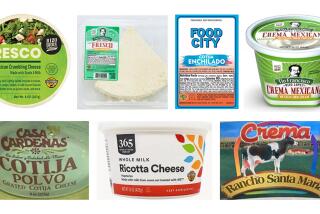Experts must sniff out source of smell at Sriracha factory
- Share via
After a judge ordered the partial shutdown of the Sriracha hot sauce plant in Irwindale, experts must now determine which parts of the factory’s operation cause odors — a decision that could affect next year’s sauce supply.
Sauce maker Huy Fong Foods has already ground all the chiles for next year’s supply of Sriracha hot sauce. The raw materials for its three sauces, Sambal Oelek, Sriracha, and Chili Garlic, are created during a three-month harvesting and production cycle that concluded earlier this month.
But the sauce must still be mixed, poured, bottled and boxed, and so far, the city and the factory have not been able to agree on where the smell is coming from or how to mitigate it.
Irwindale City Atty. Fred Galante said that he does not want to speculate whether the injunction will affect next year’s supply. Both the city and the factory have retained separate air quality consultants.
“We have to rely on the experts to determine which parts of the operations have the potential to cause odors,” Galante said.
Huy Fong Foods officials did not comment specifically on the ruling or elaborate on whether the factory would be able to continue operations. A source with knowledge of the business said there should be no effect on next year’s supply of hot sauce.
Chief executive David Tran released a statement thanking the fans of the hot sauce for their support. The statement was largely identical to a previous statement released to The Times, except for a response to residents claiming that the odor emanating from the factory was similar to that of capsaicin, an active ingredient in pepper spray.
“We don’t make tear gas here,” Tran wrote in the statement.
Inspectors with the South Coast Air Quality Management District, which is traditionally the lead agency in declaring odors a public nuisance, have not issued a violation. Although inspectors have verified smells on three different occasions, the complaints must come within the space of a day and the inspectors must be able to track the smells back to the plant. That threshold has not been met, said spokesman Sam Atwood.
The city of Irwindale filed a public nuisance claim against Huy Fong Foods on Oct. 21 after a month-long disagreement over where the smell was coming from and how to mitigate it. Residents, beginning with an Irwindale city councilman’s son, had complained of a spicy, painful smell that was inflaming respiratory conditions, causing nosebleeds and even heartburn in one case.
Judge Robert H. O’Brien sided with Huy Fong Foods at first, denying the city’s request for a temporary restraining order. But in a ruling Tuesday, O’Brien wrote that the odor could be “reasonably inferred to be emanating from the facility,” and determined that the city is “likely to prevail” in declaring the odor a public nuisance.
Sales of Sriracha have grown by about 20% each year since Tran created it. In 2012, Huy Fong Foods sold $60 million worth of the sauce, aided by a newfound popularity on the Internet. The sauce has also inspired a cottage industry of Sriracha-inspired products like iPhone cases, cookbooks, Subway sandwiches, Lay’s potato chip flavors, a food festival and even a lip balm.
More to Read
Sign up for Essential California
The most important California stories and recommendations in your inbox every morning.
You may occasionally receive promotional content from the Los Angeles Times.











